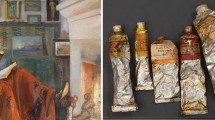Abstract
A collection of 76 synthetic organic pigments was analysed using pyrolysis–gas chromatography/mass spectrometry (Py-GC/MS). The purpose of this work was to expand the knowledge on synthetic pigments and to assess characteristic pyrolysis products that could help in the identification of these pigments in paint samples. We analysed several classes of synthetic pigments not previously reported as being analysed by this technique: some metal complexes, β-naphthol pigment lakes, BONA pigment lakes, disazopyrazolone, triarylcarbonium, dioxazine, anthraquinone, indanthrone, isoindoline and thioindigo classes. We also report for the first time the Py-GC/MS analysis of a number of naphthol AS, benzimidazolone, phthalocyanine and perylene pigments and other miscellaneous pigments including pigments with unpublished chemical structure. We successfully used the Py-GC/MS technique for the analysis of paints by artists Clyfford Still and Jackson Pollock to identify the synthetic organic pigments and the binding media.

Pyrogram of PR49, with fragments produced by pyrolysis




















Similar content being viewed by others
References
Society of Dyers and Colourists (1971) Colour index 1971. third ed., Bradford
Herbst W, Hunger K (2004) Industrial organic pigments: production, properties, applications, 3rd edn. Wiley-VCH, Weinheim
Bell IM, Clark RJH, Gibbs PJ (1997) Raman spectroscopic library of natural and synthetic pigments. Spectrochim Acta A 53:2159–2179
Burgio L, Clark RJH (2001) Library of FT-Raman spectra of pigments, minerals, pigment media and varnishes, and supplement to existing library of Raman spectra of pigments with visible excitation. Spectrochim Acta A 57:1491–1521
Ropret P, Centeno SA, Bukovec P (2008) Raman identification of yellow synthetic organic pigments in modern and contemporary paintings: reference spectra and case studies. Spectrochim Acta A 69:486–497
Scherrer NC, Stefan Z, Francoise D, Annette F, Renate K (2009) Synthetic organic pigments of the 20th and 21st century relevant to artist’s paints: Raman spectra reference collection. Spectrochim Acta A 73:505–524
Vandenabeele P, Moens L, Edwards HGM, Dams R (2000) Raman spectroscopic database of azo pigments and application to modern art studies. J Raman Spectrosc 31:509–517
Fremout W, Saverwyns S (2012) Identification of synthetic organic pigments: the role of a comprehensive digital Raman spectral library. J Raman Spectrosc 43:1536–1544
Lomax SQ, Schilling M, Learner T (2007) The identification of synthetic organic pigments by FTIR and DTMS. Modern paints uncovered. Getty Conservation Institute, Tate Modern, London
Menke CA, Rivenc R, Learner T (2009) The use of direct temperature-resolved mass spectrometry (DTMS) in the detection of organic pigments found in acrylic paints used by Sam Francis. Int J Mass Spectrom 284:2–11
Boon JJ, Learner T (2002) Analytical mass spectrometry of artists’ acrylic emulsion paints by direct temperature resolved mass spectrometry and laser desorption ionisation mass spectrometry. J Anal Appl Pyrolysis 64(2):327–344
Kirby DP, Khandekar N, Sutherland K, Price BA (2009) Applications of laser desorption mass spectrometry for the study of synthetic organic pigments in works of art. Int J Mass Spectrom 284:115–122
Sonoda N (1999) Characterization of organic azo-pigments by pyrolysis-gas chromatography. Stud Conserv 44(3):195–208
Learner T (2004) Analysis of modern paints. Getty Conservation Institute
Russell J, Singer BW, Perry JJ, Bacon A (2011) The identification of synthetic organic pigments in modern paints and modern paintings using pyrolysis-gas chromatography–mass spectrometry. Anal Bioanal Chem 400:1473–1491
Lomax SQ, Learner T (2006) A review of the classes, structures, and methods of analysis of synthetic organic pigments. J Am Inst Conserv 45(2):107–125
Szafran Y, Rivers L, Phenix A, Learner T, Landau EG, Martin S (2014) Jackson Pollock’s mural: the transitional moment. Getty
Stenger J, Kwan EE, Eremin K, Speakman S, Kirby D, Stewart H, Huang SG, Kennedy AR, Newman R, Khandekar N (2010) Lithol red salts: characterization and deterioration. e-PS web edition, 7, 147–157
Pratt LS (1947) The chemistry and physics of organic pigments. Wiley, New York
Piccirillo A, Scalarone D, Chiantore O (2005) Comparison between off-line and on-line derivatisation methods in the characterisation of siccative oils in paint media. J Anal Appl Pyrolysis 74(1–2):33–38
Dredge P, Schilling MR, Gautier G, Mazurek J, Learner T, Wuhrer R (2013) Lifting the lids off Ripolin: a collection of paint from Sidney Nolan’s studio. J Am Inst Conserv 52(4):213–226
Eastaugh N, Walsh V, Chaplin T, Siddall R (2008) Pigment compendium. Elsevier
Sobel D, Anfam D (2012) Clyfford Still—the artist’s museum. Skira Rizzoli, New York
Bonaduce I, Andreotti A (2009) Py-GC/MS of organic paint binders. In Organic Mass Spectrometry in Art and Archaeology. Wiley
Shedrinsky A, Baer NS (2006) The application of analytical pyrolysis to the study of cultural materials. In Applied Pyrolysis Handbook (II ed). CRC
Chiavari G, Prati S (2003) Analytical pyrolysis as diagnostic tool in the investigation of works of art. Chromatographia 58(9–10):543–554
Learner T The analysis of synthetic paints by pyrolysis-gas chromatography–mass spectrometry (PyGCMS). Stud Conserv 46: 4 225–241
Scalarone D, Chiantore O (2004) Separation techniques for the analysis of artists’ acrylic emulsion paints. J Sep Sci 27:263–274
Sonoda N, Rioux JP (1990) Identification des matériaux synthétiques dans les peintures modernes I. Vernis et liants polymères. Stud Conserv 35(4):189–204
Peris-Vicente J, Baumer U, Stege H, Lutzenberger K, Gimeno-Adelantado JV (2009) Characterization of commercial synthetic resins by pyrolysis-gas chromatography/mass spectrometry: application to modern art and conservation. Anal Chem 81(8):3180–3187
Author information
Authors and Affiliations
Corresponding author
Electronic supplementary material
Below is the link to the electronic supplementary material.
ESM 1
(PDF 220 kb)
Rights and permissions
About this article
Cite this article
Ghelardi, E., Degano, I., Colombini, M.P. et al. Py-GC/MS applied to the analysis of synthetic organic pigments: characterization and identification in paint samples. Anal Bioanal Chem 407, 1415–1431 (2015). https://doi.org/10.1007/s00216-014-8370-y
Received:
Revised:
Accepted:
Published:
Issue Date:
DOI: https://doi.org/10.1007/s00216-014-8370-y




